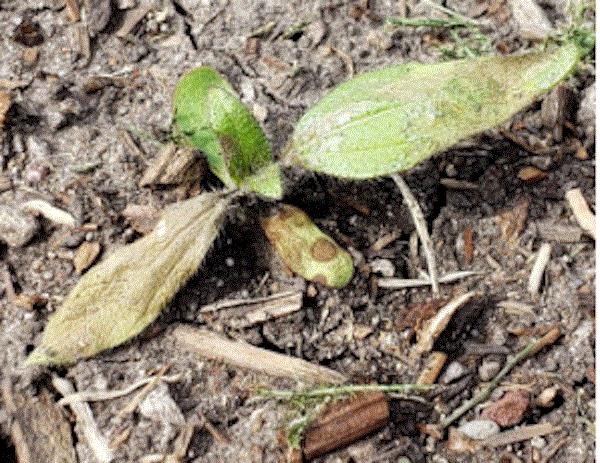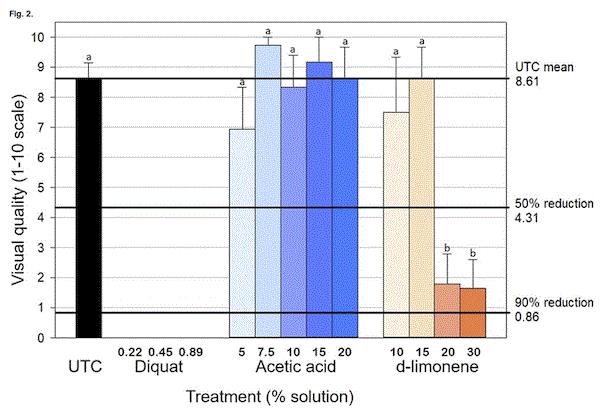Vinegar vs. terrestrial weeds
In addition to turfgrass and ornamental plants, I also work with vegetables, focused primarily on biological and cultural pest management options. It hurts my pride, a little, but I have to admit that weeds, not insects, are the major pest management issues in organic vegetable production. One of my colleagues lamented that, ever since embarking on an organic vegetable research, he now has to be a weed scientist instead of soil microbiologist.
How do y’all manage weeds in vegetable production? eOrganic website has a series of articles, webinars and videos on weed management in organic vegetable production, which I think a conventional producer or a home gardener can also benefit from. Let’s start with a great introductory piece by Mark Schonbeck of the Virginia Association for Biological Farming; click here. You can explore the eOrganic website for more resources.
Weed management can be challenging in greenhouses and nurseries. Check out two articles on weed management in greenhouses by Debaline Saha (of Michigan State University Extension).
One item on Debaline’s list of herbicides for greenhouse use caught my eye: acetic acid, a.k.a. vinegar. I never really thought of vinegar as a weed management product. Acetic acid ruptures cells and causes fluid to leak. Eventually the weeds dry out. Thorough spray coverage is critical because acetic acid is a contact, non-selective, post-emergent herbicide.

Sunflower seedling one day after treatment with household vinegar (5% acetic acid). (Photo credit: Jane Mangold, Montana State University)
Although considered organic by some, Organic Materials Review Institute (OMRI) doesn’t list any acetic acid product for pest control. OMRI listed several acetic acid products as crop management tools and production aids without claims of pesticidal function.
How effective is vinegar against weeds anyway? Jane Mangold of Montana State University says, “it depends!” Click here for the blog.
Don't get mad and chalk this up as another example of scientists being vague. It really does depend on a lot of factors. These factors are
-
Acetic acid concentration: Twenty or thirty percent acetic acid is more effective in killing young leaves and growing points, and reduces the chance of resprout. Household vinegar, which is about five percent concentration, can burn down a young seedling, but if y’all want to do a good job it’s better to use products that have higher concentration.
-
Weed growth stage: Smaller and younger plants are more susceptible to control.
-
Weed species: Broadleaf species, especially those with leaves that angle up (which catch more of the spray solution), can be controlled more effectively than grasses. Efficacy against perennial species, which can resprout from roots, tubers and crowns, is lower. Repeated applications may be needed to continuously knock back perennial plants or deplete the seed bank.
-
Environment: Acetic acid tends to work better in hot and sunny conditions.
-
Surfactant: Adding a surfactant can improve efficacy.
Protect yourself: Twenty to thirty percent acetic acid is a strong acid. So, read the product label and wear personal protective equipment.

Vinegar vs. aquatic weeds
I followed the vinegary rabbit hole down and down, and found a recent study on using acetic acid and d-limonene to control aquatic weeds. The paper was published in the April 2021 issue of HortTechnology.
Lyn Gettys and colleagues at the University of Florida conducted the study. The goal of the study was to determine if acetic acid and d-limonene could be useful natural herbicides for controlling waterhyacinth and waterlettuce. The researchers also evaluated if the natural herbicides can negatively impact two desirable aquatic plants—broadleaf sagittaria and pickerelweed. If the products are effective against weeds but soft on the desirables, the study will provide natural resource managers an alternative to deal with annoying aquatic weeds while reduce synthetic herbicide use.
The researchers sprayed the herbicide solution onto aquatic plants grown in tubs. There were twelve single-product treatments, with acetic acid tested at five concentrations (five to twenty percent), d-limonene at four concentrations (ten to thirty percent), and diquat dibromide at three concentrations (0.22 to 0.89 percent; as standard for comparison). There are also thirty combination treatments of acetic acid, d-limonene and citric acid. All solutions were mixed with Induce (a surfactant) at one percent of the final solution volume. The researchers then recorded the visual quality of the plants for eight weeks, and biomass at the end of the experiment.
Lots of data, so I can't outline all of them here. If you are interested in the study, you can access the paper by clicking here.
Here is the gist:
Acetic acid and d-limonene didn't cause much damage to the desirable aquatic plants. By themselves, they also didn't do much to the aquatic weeds. Acetic acid, even at twenty percent, didn't cause significant reduction in visual quality or biomass. D-limonene damaged waterlettuce, but only when applied at concentration of twenty percent or more.

Visual quality of waterlettuce eight weeks after single-product treatment. (Source: Gettys et al. 2021, HortTechnology 31: 225-233)
Combinations of ten percent acetic acid with d-limonene (at almost all concentrations) reduced visual quality of waterlettuce. The concentration of acetic acid had to be increased to twenty percent when using the combination against waterhyacinth. Adding citric acid to the combinations didn’t help with improving control. The combination treatments had no adverse effect on the desirable plant species. So, the combination of acetic acid and d-limonene may be suitable for folks who want a natural option for managing these aquatic weeds. But …

Visual quality of waterhyacinth (A) and waterlettuce (B) eight weeks after treatment with combinations of acetic acid and d-limonene at varying concentrations. (Source: Gettys et al. 2021, HortTechnology 31: 225-233)
Synthetic herbicide was the most effective and cheapest option. Treating the same area with natural products will increase the material-only cost by 2500 percent for waterhyacinth and 2100 percent for waterlettuce, when compared to diquat bromide.
Natural products may have their place, but y’all will have to do the math yourself to see if it’s worth the extra cost.

FYI: product cancellations
EPA announced the cancellation of cryolite and propazine registrations, effective June 8th. Complete phase-out will happen within a year. Read the cancellation notice by clicking here.
If you say, “Cryo-what?” I don't blame y’all for not knowing what it is. I don't know anyone in our industry that is actually using cryolite and propazine, so I think there won’t be much impact to us. This last item in today’s newsletter is just FYI.
Cryolite, a.k.a. sodium aluminofluoride, is a mineral used in aluminum processing. Kryocide insecticide is a product available for controlling caterpillars and beetles on ornamental shade trees. The Insecticide Resistance Action Committee, or IRAC, categorized cryolite as a non-specific multi-site inhibitor (IRAC 8C). It has the same mode of action as borax and boric acid.
Propazine is a WSSA Group 5 herbicide, used for pre-emergence control of various broadleaf weeds in sorghum. It’s known as an endocrine disruptor. Propazine 4L is registered for use in sorghum. But, if you read the label carefully, use on container grown ornamentals is also allowed though no rate and application information are provided. Again, I don't think anyone is using propazine in nurseries, so many in our industry won’t lament its cancellation. Sorghum growers in Texas, Oklahoma and Kansas, on the other hand, may feel differently.

Last items, really!
I know I’m long-winded, but these are really the last items for today.
Ray Cloyd of Kansas State University just published a new extension paper on insecticide resistance management in greenhouses. Ray included several rotation examples for different pests in this article. Click here to get a copy.
I’ll also be talking about resistance management and insecticide rotation at Cultivate’21. And, I’ll chat with you about managing mealybugs too. Check out Cultivate’s schedule for more details.
See y'all later!

JC Chong
Professor of Entomology at Clemson University
This e-mail received by 26,766 subscribers like you!
If you're interested in advertising on PestTalks contact Kim Brown ASAP!